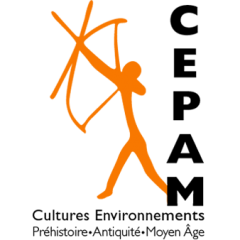Atelier 1 : définition archéologique et juridique
Grenoble • Université Grenoble Alpes • 15-16 novembre 2016
Coordination : Ricardo González Villaescusa (Université Nice – Sophia Antipolis / CEPAM), Michel Tarpin (Université Grenoble Alpes / LUHCIE)
Organisation : Université Grenoble Alpes / EA 7421 (LUHCIE, Grenoble), Université Nice – Sophia Antipolis / UMR 7264 (CEPAM, Nice), École des hautes études hispaniques et ibériques (Casa de Velázquez, Madrid)
Collaboration : Universidad d’Alacant, Universitat Autònoma de Barcelona
MARDI 15/11
UFR SH, salle de réunion, entresol
14h-17h30
Ouverture
Laurent Callegarin
Directeur des études (Casa de Velázquez, Madrid)
Introduction
Ricardo González Villaescusa
Université Nice – Sophia Antipolis
et Michel Tarpin
Université Grenoble Alpes
Modérateur
Laurent Callegarin
Directeur des études (Casa de Velázquez, Madrid)
Marie-Claire Ferriès, Clément Chillet (Université Grenoble Alpes, LUHCIE)
Présentation du programme scientifique COSTATE
Ricardo González Villaescusa (Université Nice – Sophia Antipolis), Anne-Florence Baroni (UMR 8210, ANHIMA, Paris), Elsa Rocca (Université Paul Valéry Montpellier 3), Antonio Manuel Poveda Navarro (Universitat d’Alacant)
Présentation du programme scientifique HAMO
TABLE RONDE
Ricardo Gonzalez Villaescusa (Université de Nice – Sophia Antipolis)
Antonio Poveda (Universitat d’Alacant)
Michel Tarpin (Université Grenoble Alpes)
Frédéric Gayet (Université de Nice-Sophia Antipolis)
Anne-Florence Baroni (UMR 8210, ANHIMA, Paris)
Elsa Rocca (Université Paul Valéry Montpellier 3)
Marie-Claire Ferriès (Université Grenoble Alpes)
Clément Chillet (Université Grenoble Alpes)
Oriol Olesti (Universitat Autònoma de Barcelona)
Lorenzo Gagliardi (Università degli Studi di Milano)
MERCREDI 16/11
UFR SH, salle de réunion, entresol
9h-12h30
Présidence
Oriol Olesti
Universitat Autònoma de Barcelona
Antonio Manuel Poveda Navarro
Universitat d’Alacant
Fora. Origen y causas de su fundación en Hispania
Michel Tarpin
Université Grenoble Alpes
Fonder une ville, déduire une colonie, instituer un municipe : complexité de la création d’établissements urbains
Lorenzo Gagliardi
Università degli studi di Milano
Incolae e principali norme inerenti al trasferimento di domicilio
Frédéric Gayet
et Ricardo González Villaescusa
Université Nice – Sophia Antipolis
Fondation et évolution des fora en Gaule
Résumé
La présente rencontre est à la fois la conclusion du programme Communautés Nouvelles, piloté à Grenoble entre 2012 et 2016 par l’ex-CRHIPA et le lancement officiel des programmes internationaux HaMo et COSTATE, qui développent de nouveaux aspects de l’analyse des communautés et des agglomérations antiques. Communautés Nouvelles interrogeait, à travers des séminaires internationaux où la discussion avait une large place, la manière dont des communautés se formaient et prenaient corps, indépendamment du fait urbain en soi. Mais certaines régions de l’Empire romain et certains faits archéologiques n’y ont été qu’effleurés. Les nouveaux projets, dont l’un s’inscrit dans les programmes pluriannuels de la Casa de Velázquez et l’autre est soutenu par l’École française de Rome, développeront des aspects encore peu explorés, comme les fora ou l’articulation des différents types d’agglomérations / communautés en Afrique. Ces journées d’étude internationales sont destinées en premier lieu à assurer une bonne coordination entre les projets, à en préciser les objectifs et les moyens et à établir un état des compétences à mobiliser. Il sera donc composé d’une table ronde à laquelle participeront les chercheurs impliqués dans ces différents projets ainsi que de brefs bilans scientifiques sur des points particuliers des thèmes abordés.
Secrétariat
Catherine Brun, LUHCIE – UGA, +33 4 76 82 73 69 ; catherine.brun@univ-grenoble-alpes.fr
Lieu de la manifestation :
Salle de réunion, UFR SH,
Bâtiment ARSH
Domaine Universitaire
1281, avenue Centrale
38 400 Saint-Martin d’Hères
(réception : +33 4 76 82 73 50)
Logos :
1. Université Grenoble Alpes
2. EA 7421 (LUHCIE, Grenoble)
3. École des hautes études hispaniques et ibériques (Casa de Velázquez, Madrid)
4. Université Nice – Sophia Antipolis
5. UMR 7264 (CEPAM, Nice)
Web : page(s) web à indiquer (si le programme en possède en propre)
http://luhcie.univ-grenoble-alpes.fr/ (pas encore mis en ligne !
Images :
Tabula Peutingeriana (segmentum II, avec le fac-similé de Konrad Miller de 1887)
Si nécessaire, prévoir plan d’accès.
http://sh.upmf-grenoble.fr/l-ufr-sh/coordonnees-et-contact/
Nombre d’exemplaires à tirer (à renseigner par l’EHEHI) :
brochure : 100
affiche : 25
Coordonnées électroniques (adresses mail) et adresses postales des coordinateurs :
michel.tarpin@univ-grenoble-alpes.fr
Liste et coordonnées électroniques (adresses mail) des participants :
Ricardo.GONZALEZ@unice.fr
Frederic.GAYET@unice.fr
michel.tarpin@univ-grenoble-alpes.fr
antonio.poveda@ua.es
oriol.olesti@uab.cat
marie-claire.ferries@univ-grenoble-alpes.fr
clement.chillet@univ-grenoble-alpes.fr
elsa.rocca@club-internet.fr
aflorence.baroni@gmail.com
lorenzogagliardi@yahoo.it
peqod@hotmail.com (Sisani)
laurent.callegarin@casadevelazquez.org
Pour les manifestations hors de la Casa de Velázquez, adresse(s) postale(s) pour l’envoi des documents sous la forme d’un colis (affiche, diptyque, chemises cartonnées…) : (indiquer le nom du destinataire et son téléphone)
LUHCIE
Université Grenoble Alpes
Bâtiment ARSH
CS 40700
38058 Grenoble cedex
catherine.brun @univ-grenoble-alpes.fr

